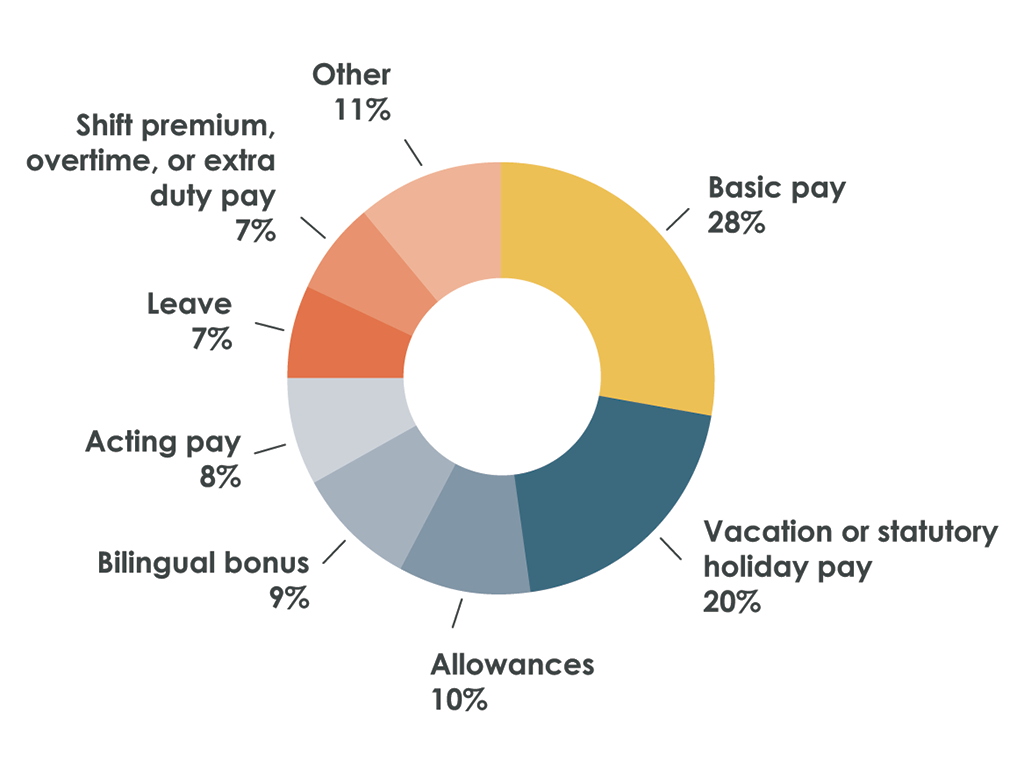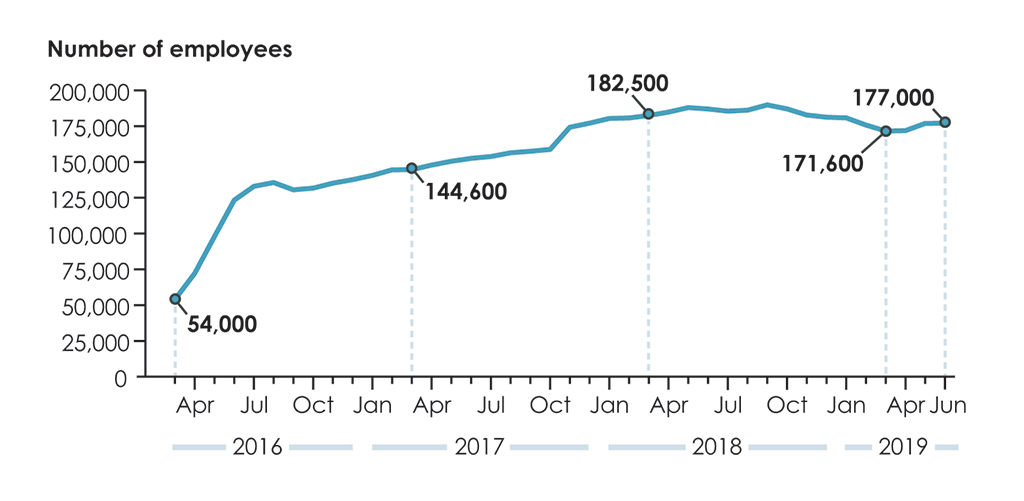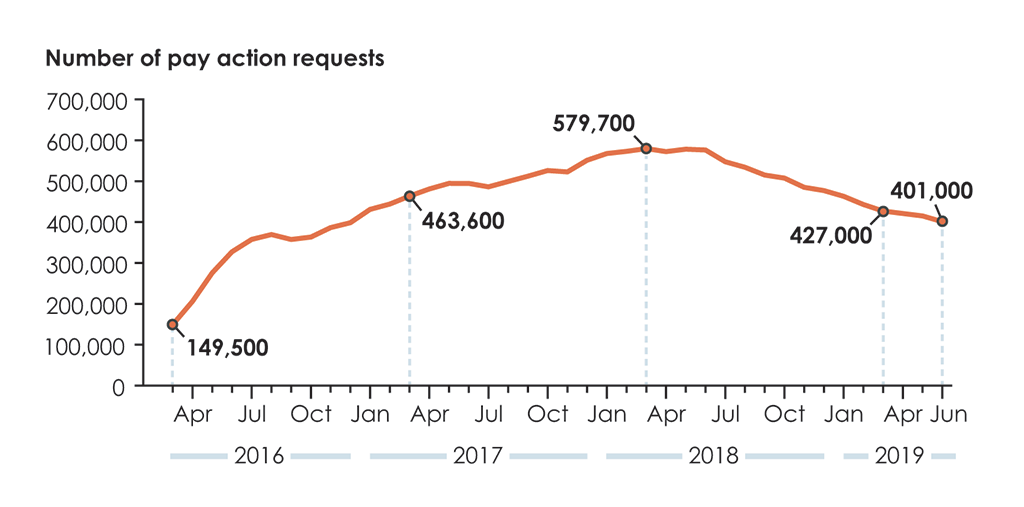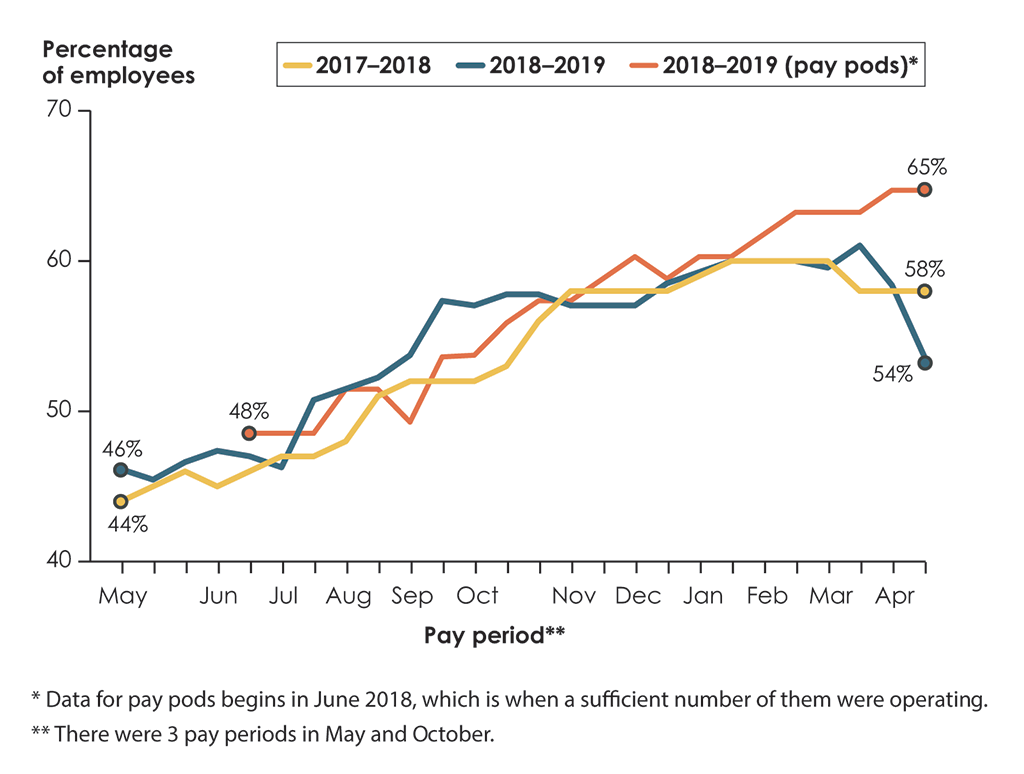The Auditor General’s observations on the Government of Canada’s 2018–2019 consolidated financial statements
The Auditor General’s observations on the Government of Canada’s 2018–2019 consolidated financial statements
Pay administration
For the past few years, we have reported on the challenges the Government of Canada has faced in accurately paying its employees because of the Transformation of Pay Administration Initiative. We do so again this year.
When it was implemented, the Transformation of Pay Administration Initiative centralized pay services for 46 departments and agencies in a newly created Public Service Pay Centre and introduced the Phoenix pay system for all 101 departments and agencies. In the 2018–2019 fiscal year, Phoenix processed approximately $25 billion in pay expenses, the same amount as in the 2017–2018 fiscal year.
As in prior years, as part of our audit of the 2018–2019 consolidated financial statements of the Government of Canada, we selected a sample of employees across all departments and agencies and tested the accuracy of their pay transactions. We found that 67% of the employees in our sample were paid incorrectly at least once during the fiscal year, compared with 62% in the 2017–2018 fiscal year. As at 31 March 2019, 54% of the employees in our sample still required corrections to their pay, compared with 58% as at 31 March 2018. Overall, we found limited improvement compared with the previous fiscal year.
We estimated that the government owed employees $349 million (because the employees were underpaid) and employees owed the government $361 million (because they were overpaid). In other words, there were approximately $710 million worth of pay errors as at 31 March 2019, compared with $615 million as at 31 March 2018.
Since 1 April 2016, we have been testing employees’ pay transactions as part of the audit of the Government of Canada’s consolidated financial statements. Because errors in employee pay continue, we selected a sample of transactions in which we identified an error in prior years to see if they had been corrected. We found that for almost two thirds of employees in our sample, the same errors remained.
Despite continued pay errors, we were still able to conclude that pay expenses were presented fairly in the Government of Canada’s 2018–2019 consolidated financial statements, because overpayments and underpayments made to employees partially offset each other. In addition, the government recorded year-end accounting adjustments to improve the accuracy of its pay expenses. These adjustments changed only the reported pay expenses in the consolidated financial statements. They did not correct the underlying problems in paying employees accurately, nor did they correct the pay errors for individual employees.
Data quality. To pay employees accurately, a pay system needs quality data: data that is accurate, complete, and up to date. Departments and agencies need to submit accurate and complete information to compensation advisors in order to update an employee’s pay. If this information is incomplete or late, keeping accurate pay records is difficult. Inaccurate pay records can result in errors in pay calculations, which usually requires manual correction. Some examples of pay errors from our audit testing were as follows:
- Documents that were needed to process a change in pay of an employee who was transferred from an agency to a department in September 2018 were not submitted until January 2019. As a result, that employee’s salary was not updated for the new role and had still not been corrected by 31 March 2019.
- A document that was needed to process an approved leave with income averaging arrangement for an employee was submitted to the Public Service Pay Centre in June 2017 with incorrect information about leave periods for September 2017. As a result, the pay centre did not process the change, and the employee went on leave without any decrease in pay. The overpayment had still not been corrected as of 31 March 2019.
Pay elements. The number of elements that make up an employee’s pay, each with its own set of rules and payment frequencies, adds to the volume of errors and the complexity of processing payroll transactions. All of these pay elements are interconnected. An error in one element can affect others, resulting in complex pay calculations.
Exhibit 4 shows the elements of employee pay in which we noted errors during our audit work for 2018–2019. These elements and the percentages were similar to those we reported last year.
Exhibit 4—Elements of employee pay for which we found errors in our testing

Exhibit 4—text version
This pie chart shows the elements of employee pay in which we noted errors during our audit work for 2018–2019. Basic pay accounted for the greatest proportion of total errors in employee pay, at 28%. Next was vacation or statutory holiday pay at 20%; allowances at 10%; bilingual bonus at 9%; acting pay at 8%; leave at 7%; and shift premium, overtime, or extra duty pay at 7%. Other elements of employee pay accounted for the remaining 11% of errors we noted.
We continue to be of the view that decreasing the complexity of the pay rules governing employees’ pay could reduce errors. Streamlining pay rules could minimize the risk of human error when compensation advisors calculate and process pay manually. Any additional errors further increase the existing backlog of pay action requests that has been growing since the Transformation of Pay Administration Initiative was implemented in 2016.
Backlog of pay action requests. In our observations last year, we reported on the number of employees with outstanding pay action requests in the 46 departments and agencies served by the Public Service Pay Centre. As of March 2019, there were 171,600 employees (compared with 182,500 in 2018) with almost 427,000 pay action requests remaining to be processed (compared with 579,700 in 2018).
In June 2019, which was 3 months after the government’s fiscal year-end, the backlog of outstanding requests was 401,000, which affected 177,000 employees. This meant that although the number of outstanding requests declined, the number of employees affected increased since the end of the fiscal year. Furthermore, almost half of the requests were over a year old. Therefore, the pay of thousands of employees continued to be inaccurate for long periods of time.
If employees have previous requests that have not been resolved, their current and future pay could have additional errors. In one of the examples in our sample for audit testing, we found that an error in the calculation of an employee’s pay raise meant that the employee was underpaid every year, including the current fiscal year. The compounding of this error over several years meant that this employee was underpaid by approximately $70,000.
Exhibit 5 shows the number of employees with outstanding pay action requests, and Exhibit 6 shows the number of outstanding pay action requests. These exhibits show only the backlog for the 46 departments and agencies served by the pay centre. They do not show the pay action requests in the other departments and agencies.
Exhibit 5—Number of employees with outstanding pay requests in the 46 departments and agencies served by the Public Service Pay Centre

Source: Based on the Office of the Auditor General of Canada’s analysis of data in Public Services and Procurement Canada’s Case Management Tool
Exhibit 5—text version
This line chart shows the number of employees with outstanding pay requests in the 46 departments and agencies served by the Public Service Pay Centre. The chart shows that from March 2016 to June 2019, the number of employees with outstanding pay requests went from 54,000 to 177,000.
In March 2016, there were 54,000 employees with outstanding pay requests in the 46 departments and agencies served by the Public Service Pay Centre. In March 2017, that number had risen to 144,600. In March 2018, that number had risen to 182,500. In March 2019, that number had declined to 171,600. In June 2019, that number had risen to 177,000.
Source: Based on the Office of the Auditor General of Canada’s analysis of data in Public Services and Procurement Canada’s Case Management Tool
Exhibit 6—Number of outstanding pay action requests for the 46 departments and agencies served by the Public Service Pay Centre

Source: From March 2016 to June 2018, based on the Office of the Auditor General of Canada’s analysis of data in Public Services and Procurement Canada’s Case Management Tool. From July 2018 to June 2019, based on data in Public Services and Procurement Canada’s Case Management Tool.
Exhibit 6—text version
This line chart shows the number of outstanding pay requests in the 46 departments and agencies served by the Public Service Pay Centre. The chart shows that from March 2016 to June 2019, the number of outstanding pay requests went from 149,500 to 401,000.
In March 2016, there were 149,500 outstanding pay requests in the 46 departments and agencies served by the Public Service Pay Centre. In March 2017, that number had risen to 463,600. In March 2018, that number had risen to 579,700. In March 2019, that number had declined to 427,000. In June 2019, that number had declined to 401,000.
Source: From March 2016 to June 2018, based on the Office of the Auditor General of Canada’s analysis of data in Public Services and Procurement Canada’s Case Management Tool. From July 2018 to June 2019, based on data in Public Services and Procurement Canada’s Case Management Tool.
Paying employees the right amount on time and resolving the backlog of pay problems are shared responsibilities across the government. Public Services and Procurement Canada is responsible for processing payroll transactions, while the departments and agencies have an important role to play in providing complete, accurate, and up-to-date information about changes to employee pay.
In December 2017, the government implemented a new model with several objectives to resolve pay problems for the 46 departments and agencies served by the Public Service Pay Centre. This model assigns a compensation team, which it calls a “pay pod,” to a specific department or agency. The priority of these teams is to process current pay transactions first so that payments are more likely to be issued on time and transactions are not added to the backlog. Pay pods also try to resolve outstanding pay action requests in an employee’s file when they affect current pay transactions.
Pay pods were implemented over several months, and as of May 2019, all 46 departments and agencies served by the pay centre operated under this model.
As previously mentioned, for our audit of the government’s consolidated financial statements, we selected a sample of government employees whose pay was processed by the Phoenix pay system. We also performed additional testing specifically on employees covered by the pay pods this fiscal year. Given that pay pods were a new initiative, we thought that this testing could provide additional value to the government. We tested a sample of employees covered by the pay pod model from June 2018 (the first month when there was a sufficient number of pay pods operating) to March 2019. We found that 65% of sampled employees still required corrections to their pay as at 31 March 2019. Exhibit 7 shows the percentage of employees in our sample with errors in their pay for both the financial statement audit and the pay pods by pay period.
A significant amount of work remains to resolve current payroll data quality problems, including the backlog, in order to accurately pay employees and to support a successful transition to a possible new pay system.
Exhibit 7—Percentage of employees in our payroll sample with errors in their paycheques by pay period

Source: Based on the Office of the Auditor General of Canada’s analysis of a sample of employees’ pay transactions used in the audit of the consolidated financial statements of the Government of Canada for the fiscal years ending 31 March 2018 and 31 March 2019
Exhibit 7—text version
This line chart shows the percentage of employees in our sample with errors in their paycheques by pay period from 2017–2018 to 2018–2019. The chart shows the percentages for the sample of employees in the financial statement audit, and for the 2018–2019 fiscal year, the chart also shows the percentages for the sample of employees covered by the pay pods.
In May 2017, 44% of employees in our payroll sample had errors in their paycheques. That percentage rose fairly steadily throughout that fiscal year, so that by May 2018, that percentage was 58%.
In May 2018, 46% of employees in our payroll sample for the 2018–2019 financial statement audit had errors in their paycheques. By May 2019, that percentage was 54%.
Data for the pay pods begins in June 2018, which is when a sufficient number of them were operating. In June 2018, 48% of employees in our pay pod sample had errors in their paycheques. That percentage rose throughout that fiscal year, and by May 2019, it was 65%.
Note: There were 3 pay periods in May 2018 and October 2018.
Source: Based on the Office of the Auditor General of Canada’s analysis of a sample of employees’ pay transactions used in the audit of the consolidated financial statements of the Government of Canada for the fiscal years ending 31 March 2018 and 31 March 2019
National Defence inventory and asset pooled items
For 16 years, we have been reporting on National Defence’s difficulties in recording the quantities and values of its inventory. In many of these years, we have also reported on the department’s asset pooled items, which are tangible capital assets that are managed like inventory. The department manages a significant portion of the Government of Canada’s inventory and asset pooled items. Overall at National Defence, these assets amounted to $8.8 billion as at 31 March 2019.
Strong controls are needed for financial reporting purposes as federal organizations with inventory and asset pooled items must ensure that quantities and values are accurate and that obsolete items are identified and their values are reduced.
National Defence’s inventory amounted to $5.6 billion, and its asset pooled items amounted to $3.2 billion, as at 31 March 2019. As part of our audit, we noted errors in the amounts that the department reported in the quantities and values of these assets. We estimated that inventory and asset pooled items were overstated by a total of $850 million (Exhibit 8).
Exhibit 8—Estimated overstatement errors that we noted in our audit
| Overstatement error (in $ millions) | |||
|---|---|---|---|
| Type of asset | Quantity | Value | Total |
| Inventory | $100 | $170 | $270 |
| Asset pooled items | $280 | $300 | $580 |
| Total overstatement | $380 | $470 | $850 |
National Defence has to continue to improve the quality of its inventory and asset pooled items records in order to report accurate and complete data throughout an asset’s life cycle.
To resolve its challenges in properly recording the quantities and values of its inventory, National Defence submitted a long-term inventory management action plan to the House of Commons Standing Committee on Public Accounts in 2016. One of the plan’s several initiatives is to implement a system to tag all inventory and asset pooled items. The implementation of this system is expected to begin in the 2022–2023 fiscal year. In our view, errors in reported quantities are likely to continue until this system is in place.
For the second year, the department reported to the committee that it essentially met the commitments in its inventory management action plan. We reviewed documentation and are pleased with the continued progress to meet its 2018–2019 commitments.
